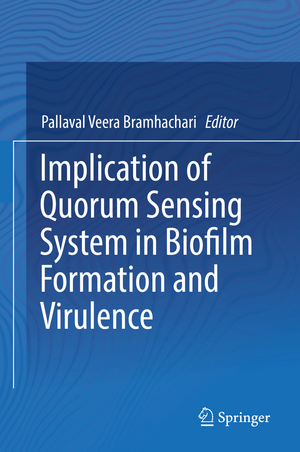Implication of Quorum Sensing System in Biofilm Formation and Virulence
Editat de Pallaval Veera Bramhacharien Limba Engleză Hardback – 12 feb 2019
Finally, the book also elucidates a comprehensive yet a representative description of a large number of challenges associated with quorum sensing signal molecules viz. virulence, pathogenesis, antibiotic synthesis, biosurfactants production, persister cells, cell signaling and biofilms, intra and inter-species communications, host-pathogen interactions, social interactions & swarming migration in biofilms.
Preț: 1106.86 lei
Preț vechi: 1165.11 lei
-5% Nou
Puncte Express: 1660
Preț estimativ în valută:
211.79€ • 221.73$ • 175.25£
211.79€ • 221.73$ • 175.25£
Carte tipărită la comandă
Livrare economică 07-21 aprilie
Preluare comenzi: 021 569.72.76
Specificații
ISBN-13: 9789811324284
ISBN-10: 981132428X
Pagini: 340
Ilustrații: XIV, 381 p. 64 illus., 43 illus. in color.
Dimensiuni: 155 x 235 x 24 mm
Greutate: 0.73 kg
Ediția:1st ed. 2018
Editura: Springer Nature Singapore
Colecția Springer
Locul publicării:Singapore, Singapore
ISBN-10: 981132428X
Pagini: 340
Ilustrații: XIV, 381 p. 64 illus., 43 illus. in color.
Dimensiuni: 155 x 235 x 24 mm
Greutate: 0.73 kg
Ediția:1st ed. 2018
Editura: Springer Nature Singapore
Colecția Springer
Locul publicării:Singapore, Singapore
Cuprins
Module 1_Introduction to Microbial Quorum Sensing.- Module 2_Functional Aspects of Quorum Sensing in Microbes.- Module 3_Quorum Sensing regulated behaviors in Fungi.- Module 4_Quorum Sensing regulated behaviours in Gram- Negative bacteria.- Module 5_QS-regulated behaviours in Gram- Positive bacteria.
Notă biografică
Dr. P.V. Bramha Chari is currently a Faculty and Head of the Department of Biotechnology at Krishna University, India. He has earlier served as Postdoctoral Research Scientist at the Bacterial Pathogenesis Laboratory, Queensland Institute of Medical Research in Brisbane, Australia & Department of Microbiology & Cell Biology, Indian Institute of Science, Bangalore. He has completed his Ph.D. from Goa University, India. His current research work largely focuses on applied research in Microbiology & cell biology; including biochemical mechanism of bacterial EPS in sequestrating heavy metals, stress induced proteins, novel biosurfactant molecules, bacterial-biofilm formations, structure–function relationship of bacterial rhamnolipids. He has published more than 85 research articles in several prestigious peer-reviewed international journals and presented 45 abstracts at various national and international conferences. He has served as a referee for a number of National & International journals. He is a member of many international scientific societies and organizations importantly, Indian science congress, society of biological chemists, India etc. He has been conferred with various prestigious awards notably, DST Young Scientist and nominated as Associate fellow of Andhra Pradesh Academy of Sciences for the year 2016. He has obtained 2 Indian patents in 2017. He has more than 10 years of teaching and research experience at the University level.
Textul de pe ultima copertă
This book illustrates the importance and significance of Quorum sensing (QS), it’s critical roles in regulating diverse cellular functions in microbes, including bioluminescence, virulence, pathogenesis, gene expression, biofilm formation and antibiotic resistance. Microbes can coordinate population behavior with small molecules called autoinducers (AHL) which serves as a signal of cellular population density, triggering new patterns of gene expression for mounting virulence and pathogenesis. Therefore, these microbes have the competence to coordinate and regulate explicit sets of genes by sensing and communicating amongst themselves utilizing variety of signals. This book descry emphasizes on how bacteria can coordinate an activity and synchronize their response to external signals and regulate gene expression. The chapters of the book provide the recent advancements on various functional aspects of QS systems in different gram positive and gram negative organisms.
Finally, the book also elucidates a comprehensive yet a representative description of a large number of challenges associated with quorum sensing signal molecules viz. virulence, pathogenesis, antibiotic synthesis, biosurfactants production, persister cells, cell signaling and biofilms, intra and inter-species communications, host-pathogen interactions, social interactions & swarming migration in biofilms.
Caracteristici
This book explicitly elaborates the mechanism of quorum sensing in various microbial strains of medical, industrial and agricultural importance The book broadens the understanding of the role of quorum sensing in regulating diverse cellular functions in microbes, including bioluminescence, virulence, pathogenesis, gene expression, biofilm formation and antibiotic resistance The book importantly provides a comprehensive investigation of the correlation of Quorum sensing with the biofilm formation
